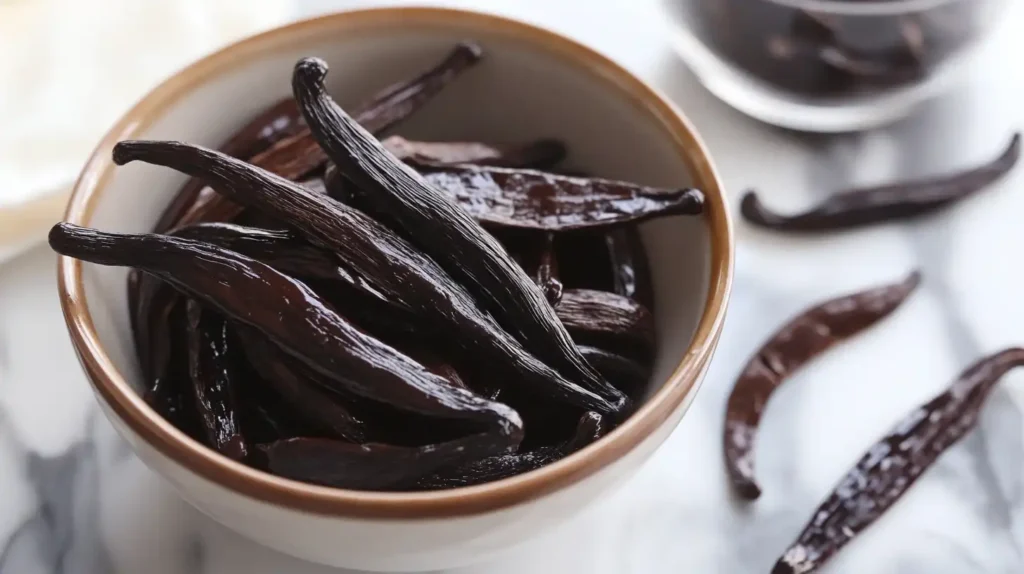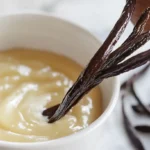Table of Contents

Introduction
Vanilla is one of the most cherished flavors in the culinary world, adding depth and sophistication to a wide range of recipes. Among its many forms, vanilla bean paste stands out for its rich flavor, convenience, and versatility. If you’ve ever wanted to elevate your desserts, learning how to make this essential ingredient is a game-changer. Check out this Crème Brûlée Recipe to see how vanilla bean paste recipe adds elegance to even the simplest treats.
What is Vanilla Bean Paste?
Vanilla bean paste is a thick, syrup-like mixture that contains the seeds of real vanilla beans. It combines the intense flavor of whole beans with the ease of use found in vanilla extract. Its thick consistency and visual flecks of vanilla seeds make it an indispensable choice for recipes like Nestle Chocolate Chip Cookies, where both taste and aesthetics matter.
Unlike vanilla extract, which is purely liquid, or whole vanilla beans, which require labor-intensive scraping, vanilla paste strikes the perfect balance for convenience and quality.
History and Origins of Vanilla Paste
The journey of vanilla bean paste begins with the vanilla plant, Vanilla planifolia, native to Mexico and first cultivated by the Totonac people. Over centuries, vanilla has become one of the most valuable spices globally. As the demand for high-quality yet convenient vanilla solutions grew, culinary innovators developed vanilla bean paste to combine luxury and simplicity.
Today, this ingredient is a go-to for recipes like Ninja Creami Desserts, where its deep flavor elevates every bite. Modern bakers rely on it for its ability to deliver a luxurious taste and consistent results.
Why Is It Popular in Baking?
There are several reasons why vanilla bean paste has become a baking staple:
- Flavor Intensity: Its concentrated flavor enhances everything from cookies to custards.
- Visual Appeal: The flecks of vanilla seeds add a gourmet touch to baked goods.
- Convenience: A single spoonful provides consistent results without the hassle of scraping beans.
- Versatility: It’s perfect for a wide array of recipes, including desserts and beverages.
Its ability to blend convenience with gourmet quality makes vanilla bean paste a favorite among home cooks and professional chefs. Dive into recipes like these Ninja Creami Desserts or a decadent Crème Brûlée to experience its full potential.
Why Choose Homemade Vanilla Bean Paste Recipe?

Homemade vanilla bean paste offers:
- Superior flavor customization.
- Cost savings compared to store-bought options.
- A pure, preservative-free alternative.
Discover how this ingredient can enhance sophisticated desserts like Crème Brûlée with its deep, aromatic profile.
Benefits of Homemade Vanilla Bean Paste Recipe
Making your own vanilla bean paste at home offers numerous advantages beyond just flavor. Here are the top reasons why crafting your own paste is a great idea:
1. Cost-Effectiveness Compared to Store-Bought
Store-bought vanilla bean paste can be expensive, especially when sourced from premium brands. By making it yourself, you can significantly cut costs while ensuring the use of high-quality ingredients. A single batch of homemade paste, crafted with a handful of vanilla beans and common kitchen ingredients, can yield enough to last months. For those who love baking recipes like Nestle Chocolate Chip Cookies, this can save you a considerable amount over time.
2. Health Benefits of Natural Ingredients
Homemade vanilla bean paste is free from artificial additives and preservatives commonly found in commercial versions. By controlling what goes into your paste, you can ensure it’s made with pure, natural ingredients. This makes it an excellent option for those seeking healthier choices in their cooking and baking. Imagine creating wholesome desserts like Crème Brûlée with a paste that is as clean as it is delicious.
Why Homemade is the Best Choice
By combining cost savings with the health benefits of natural ingredients, homemade vanilla bean paste not only enhances your culinary creations but also aligns with a more sustainable and budget-friendly lifestyle. Whether it’s used in simple treats or gourmet recipes, making your own guarantees quality and peace of mind.
Buying Guide for Vanilla Beans
Selecting the right vanilla beans is crucial for crafting high-quality vanilla bean paste. Here’s a guide to help you choose the best beans and factors to consider when purchasing.

Best Types of Vanilla Beans for Paste
- Madagascar Vanilla Beans: Known as the “gold standard” of vanilla, these beans offer a creamy, sweet flavor profile that is perfect for paste. Their high vanillin content gives a robust aroma ideal for recipes like Nestle Chocolate Chip Cookies.
- Tahitian Vanilla Beans: Slightly floral and fruity, these beans are excellent for lighter desserts and beverages. Their distinct flavor makes them a popular choice for unique creations.
- Mexican Vanilla Beans: With a bold, smoky flavor, these beans bring depth to rich recipes like Crème Brûlée or sauces.
- Ugandan Vanilla Beans: Dark, chocolaty undertones make these beans ideal for pairing with chocolate-based recipes or ice creams.
Factors to Consider When Purchasing
- Quality of Beans:
Look for plump, oily, and flexible beans. Avoid beans that appear brittle or dry, as they may lack flavor. - Vanilla Content:
Beans with visible seeds and high vanillin levels will provide better flavor and aroma. - Sourcing:
Opt for ethically sourced beans from reputable suppliers to ensure sustainability. Fair-trade options are not only better for the environment but also support the farming communities. - Packaging:
Fresh beans are often sold in vacuum-sealed or airtight packaging to preserve their quality. - Price and Authenticity:
While premium beans may cost more, they’re worth the investment for the superior taste they deliver. Be cautious of overly cheap options, which may be synthetic or low-quality.
By selecting the best vanilla beans, you ensure your vanilla bean paste delivers the most intense flavor and aroma for all your culinary endeavors. For inspiration on how to use your paste, explore recipes like Ninja Creami Desserts that benefit from the richness of high-quality vanilla beans.
Storage and Shelf Life
Proper storage is essential for maintaining the quality and longevity of your homemade vanilla bean paste. Here’s how to store it effectively and tips to naturally extend its shelf life:
How to Store Vanilla Bean Paste
- Use an Airtight Container: Transfer your paste to a sterilized, airtight jar or container to prevent air and moisture from compromising its quality.
- Store in a Cool, Dark Place: Keep the jar in a pantry or cupboard, away from direct sunlight and heat, to preserve its flavor and consistency.
- Avoid Refrigeration: While it may seem like refrigeration would extend shelf life, it can cause the paste to crystallize and alter its texture. For proper storage, follow the tips shared in our Vanilla Bean Paste Recipe Guide.
Increasing Shelf Life Naturally
- Add Alcohol: Incorporating a small amount of alcohol, such as vodka or rum, into your paste acts as a natural preservative and extends its shelf life without compromising flavor.
- Use Sterilized Equipment: Always use clean, sterilized tools and containers to prevent contamination during preparation and storage.
- Seal Tightly After Each Use: Ensure the jar is tightly sealed after every use to keep out air and moisture.
With proper care, your homemade vanilla bean paste can last up to one year, making it a long-lasting and versatile addition to your pantry. For more details on maximizing shelf life, check out our tips in the Crème Brûlée Recipe where proper paste handling plays a key role.
Ingredients You Need
For your homemade vanilla bean paste, gather these essentials:
- 5 vanilla beans: Opt for plump, high-quality beans for the best flavor.
- 1 cup sugar (or a substitute like glycerin).
- ½ cup water.
- Optional: Alcohol for preservation or glycerin for a sugar-free alternative.
Step-by-Step Guide to Vanilla Bean Paste Recipe
1: Prepare the Vanilla Beans
- Slice each vanilla bean lengthwise.
- Scrape out the seeds using a knife, reserving the pods.
2: Blend the Ingredients
- In a blender, combine vanilla seeds, pods, sugar, and water.
- Blend until smooth.
3: Simmer to Thicken
- Transfer the mixture to a saucepan.
- Simmer on low heat, stirring occasionally, until the paste reaches the desired thickness.
4: Store Properly
- Pour the cooled paste into a sterilized jar.
- Store in a cool, dark place for up to one year.
Pair this paste with recipes that call for rich flavors, like Nestle Chocolate Chip Cookies, for a deeper, more indulgent taste.
Creative Uses for Vanilla Bean Paste Recipe
This versatile ingredient shines in:
- Baking: Cookies, cakes, and pastries.
- Beverages: Coffee, milkshakes, and cocktails.
- Sauces: Sweet or savory applications like glazes or marinades.
Explore more ways to incorporate vanilla in unique recipes like Ninja Creami Desserts, which pair exceptionally well with the aromatic complexity of vanilla paste.
FAQs About Vanilla Bean Paste Recipe
1. How is Vanilla Bean Paste Made?
Vanilla bean paste is made by blending the seeds of real vanilla beans with sugar or a syrup-like base, often combined with water or alcohol. The mixture is simmered until it thickens to a paste-like consistency. To make it at home, follow our Vanilla Bean Paste Recipe for step-by-step guidance on crafting this essential ingredient.
2. What Do You Do With Vanilla Bean Paste?
Vanilla bean paste is incredibly versatile and can be used in various recipes. Add it to desserts like Crème Brûlée, cookies, and cakes for a rich vanilla flavor. It’s also perfect for beverages like coffee, milkshakes, or cocktails. Explore how it elevates recipes such as Nestle Chocolate Chip Cookies with its deep aroma and visible bean flecks.
3. What Is the Best Alcohol to Make Vanilla Paste?
For making vanilla bean paste, the best alcohol to use is a high-quality vodka. Vodka has a neutral flavor that won’t interfere with the vanilla’s natural aroma. You can also experiment with bourbon or rum for a slightly richer taste. If you’re interested in experimenting with alcohol-infused recipes, try it alongside Ninja Creami Desserts for added depth.
4. How Long Does Homemade Vanilla Bean Paste Last?
When stored properly in an airtight container and a cool, dark place, homemade vanilla bean paste can last up to one year. Ensure the jar is sterilized to extend shelf life. For more storage tips, visit our Vanilla Bean Paste Recipe Guide.
5. Which Is Stronger: Vanilla Bean Paste or Vanilla Extract?
Vanilla bean paste is generally stronger than vanilla extract due to its concentrated nature and the inclusion of real vanilla seeds. It delivers a more intense flavor and a visually appealing touch to recipes like Crème Brûlée or Nestle Chocolate Chip Cookies.
6. Does Vanilla Paste Need to Be Refrigerated?
No, vanilla bean paste does not need to be refrigerated. It is best stored in a cool, dark place, such as a pantry, to maintain its consistency and flavor. However, ensure the jar is sealed tightly to prevent contamination. For more tips on proper storage, refer to our Homemade Vanilla Bean Paste Guide.
With these insights, you’ll not only master the art of using vanilla bean paste but also enjoy its endless culinary applications!
The Future of Vanilla Bean Paste
As the demand for high-quality, natural ingredients grows, vanilla bean paste is evolving to meet modern consumer preferences. From innovative product development to sustainable sourcing, here’s what the future holds for this beloved ingredient.
Trends in Vanilla Product Development
- Infused Vanilla Pastes:
Manufacturers are experimenting with vanilla bean paste infused with complementary flavors like chocolate, citrus, and spices. These variations provide unique options for adventurous bakers looking to diversify their recipes. - Ready-to-Use Gourmet Products:
Pre-portioned and premium-grade vanilla pastes designed for specific recipes, like cookies or custards, are gaining popularity. These offer convenience while maintaining the high quality associated with handmade versions. - Clean Label Products:
The shift toward clean labels—products free of artificial additives and preservatives—is driving innovation in paste formulations. Many brands now offer organic and non-GMO vanilla bean paste options that cater to health-conscious consumers.
For bakers looking to stay ahead of these trends, experimenting with recipes like Nestle Chocolate Chip Cookies allows you to experience the depth of new vanilla innovations firsthand.
Eco-Friendly and Sustainable Practices
- Ethical Sourcing of Vanilla Beans:
Sustainability is becoming a top priority for vanilla production. Companies are partnering with local farmers to implement fair trade practices and ensure fair wages. These efforts not only support farming communities but also protect the delicate ecosystems where vanilla orchids thrive. - Reducing Environmental Impact:
Eco-conscious brands are developing packaging that minimizes waste, such as biodegradable or recyclable options. Additionally, advancements in farming techniques aim to reduce water consumption and promote organic cultivation methods. - Transparency in Supply Chains:
Consumers are demanding greater transparency about where their vanilla beans are sourced. Many companies now provide traceability, ensuring that their beans come from sustainable and ethical farms.
By prioritizing these practices, the vanilla industry is paving the way for a future that values both quality and responsibility. Whether you’re using homemade paste for recipes like Crème Brûlée or exploring new trends, these efforts make every dish more meaningful.
The continued focus on eco-friendly production and innovation ensures that vanilla bean paste will remain a staple in kitchens for years to come.
Conclusion
Vanilla bean paste is more than just a flavorful ingredient; it’s a symbol of quality and sophistication in cooking and baking. Whether you’re creating classic recipes like Crème Brûlée or exploring modern dessert trends with Ninja Creami Desserts, this versatile paste elevates every dish it touches.
By making your own vanilla bean paste at home, you can enjoy the benefits of cost savings, natural ingredients, and the satisfaction of crafting a superior product. Proper storage and sourcing ensure that your paste retains its incredible flavor for months, making it a valuable addition to your pantry.
As the culinary world continues to innovate, trends in vanilla products and eco-friendly practices promise exciting opportunities for both professionals and home bakers. With this guide, you’re well-equipped to explore the endless possibilities of vanilla bean paste and take your creations to the next level.
Print
How to Make the Perfect Vanilla Bean Paste Recipe
- Total Time: 25 minutes
- Yield: 2 servings
Ingredients
5 vanilla beans
1 cup sugar
½ cup water
Instructions
1: Prepare the Vanilla Beans
- Slice each vanilla bean lengthwise.
- Scrape out the seeds using a knife, reserving the pods.
2: Blend the Ingredients
- In a blender, combine vanilla seeds, pods, sugar, and water.
- Blend until smooth.
3: Simmer to Thicken
- Transfer the mixture to a saucepan.
- Simmer on low heat, stirring occasionally, until the paste reaches the desired thickness.
4: Store Properly
- Pour the cooled paste into a sterilized jar.
- Store in a cool, dark place for up to one year.
- Prep Time: 15 minutes
- Cook Time: 20 minutes
- Category: Dessert
- Method: Baking
- Cuisine: Italian-American


Appreciate this post. Will try it out.